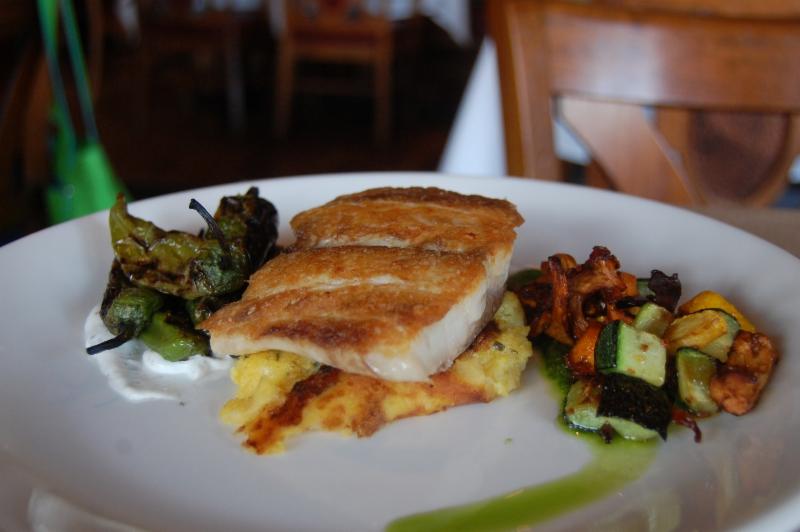What's Happening in That Building Near Fisheries
Story and photo
by Gordy Gotsch/McGraw
If you drive past the Fisheries Research Building these days, you'll see a structure that houses one of the most exciting new research projects at McGraw in many years: Our Aquaponics Center.
So - what does that mean?
Aquaponics is a system that combines recirculating aquaculture (raising aquatic animals such as fish, shrimp, or crayfish) with hydroponics (cultivating plants in water) in a symbiotic relationship -- the nutrient-rich water that results from raising fish provides the nutrients for the plants. As the plants consume the nutrients, they help clean the water for the fish.
You don't need to use fertilizer or herbicides; the fish waste feeds the plants and there is no soil that can allow weeds to grow.
Best of all, since you don't need soil you can set up aquaponics anywhere -- in urban areas, in arid regions with poor soil, or, in the case of McGraw, a former parking lot. The end result is fresh produce and protein.
|
|

Do Duck Population Estimates Really Add Up?
By Dennis Anderson/Star Tribune
Photo by Brian Scott/flickr
Duck hunters and others who care about mallards, teal, wood ducks and other fowl, and who have long suspected a disconnect between duck managers and the real world, were boosted in their beliefs recently when the U.S. Fish and Wildlife Service (FWS) issued its annual waterfowl population status report.
Those who pay attention to these matters will recall that in August each year the FWS issues volumes of waterfowl data based largely on springtime overflights of key North American duck and goose breeding areas by pilot-and-spotter teams. Waterfowl-counting ground crews supplement the aerial survey.
In years past, the service also conducted midsummer production surveys to assess the success (or not) of ducks in bringing off broods. This was considered important because weather and, therefore, nesting conditions are highly variable, and that variability - such as the receipt of heavy rains or the onset of drought - can affect waterfowl production and migration.
The service no longer conducts these surveys, citing labor costs among their reasons.
|
Zinke Pushes Yellowstone
Mining Ban
Associated Press
Photo by Paul Fundenberg/flickr
U.S. Interior Secretary Ryan Zinke wants to speed up a proposal to block new gold mining claims on forested public lands in Montana near Yellowstone National Park and will also consider blocking other types of mining, agency officials said.
Federal officials are undergoing a two-year review of mining on more than 30,000 acres among the towering peaks of the Absaroka mountains just north of the park.
The review was launched last year by Zinke's predecessor, former Interior Secretary Sally Jewell, in response to local concerns that two proposed gold mines could profoundly alter the character of a region heavily dependent on hikers, hunters and tourists.
Interior spokeswoman Heather Swift said that Zinke wants to move forward as quickly as possible with a proposed 20-year withdrawal of future mining claims in the area north of the park, known as Paradise Valley. The review of that withdrawal was scheduled to be completed by the U.S. Forest Service and Interior's Bureau of Land Management by November, 2018.
|

Fish Eating More Plastic. Worse, They May Like It
By Matthew Savoca/The Washington Post
Photo by Stu Spivack/flickr
As you bite down into a delicious piece of fish, you probably don't think about what the fish itself ate - but perhaps you should. More than 50 species of fish have been found to consume plastic trash at sea. This is bad news, not only for fish but potentially also for humans who rely on fish for sustenance.
Most distressingly for people, toxic compounds that are associated with plastic transfer to and bioaccumulate in
fish tissues
. This is troubling because these substances could further bioaccumulate in people who consume fish that have eaten plastic. Numerous species sold for human consumption, including mackerel, striped bass and Pacific oysters, have been found with these
toxic plastics in their stomachs
.
|

Remembering McGraw Member Ron Desideri
McGraw is mourning longtime member Ron Desideri, who passed away on August 30 at age 83.
Mr. Desideri, of Oak Brook, joined McGraw in 1998. An avid outdoorsman, he frequently won McGraw's clay target competitions and also enjoyed hunting upland birds at the Foundation. He was an ardent supporter of the Foundation's research programs as well.
In his private life, Mr. Desideri was an entrepreneur, learning the electrical trade and later acquiring MG Electric Co. He was a veteran of the Marine Corps, and is survived by Diones, his wife of 63 years; four children,
Denise Schluckebier (Paul), Lawrence Desideri (Deidre), Lisa Desideri (Joe Wargin) and Thomas Desideri (Janice); four grandchildren; a brother, and three sisters.
The family has kindly asked that donations in Mr. Desideri's memory be sent to the Max McGraw Wildlife Foundation.
|
|
|
|
|
|